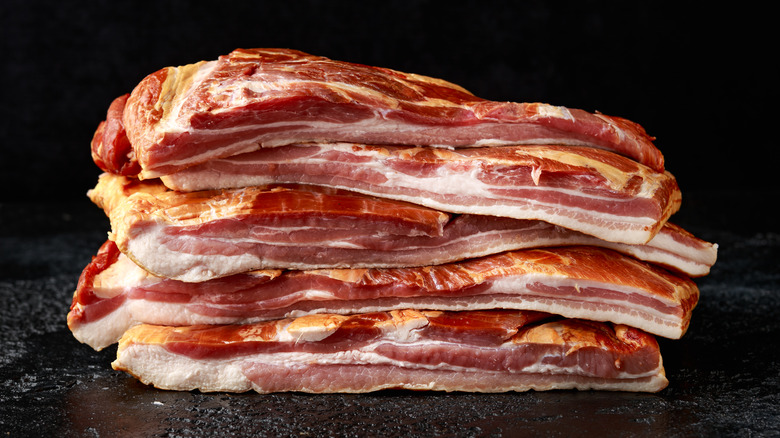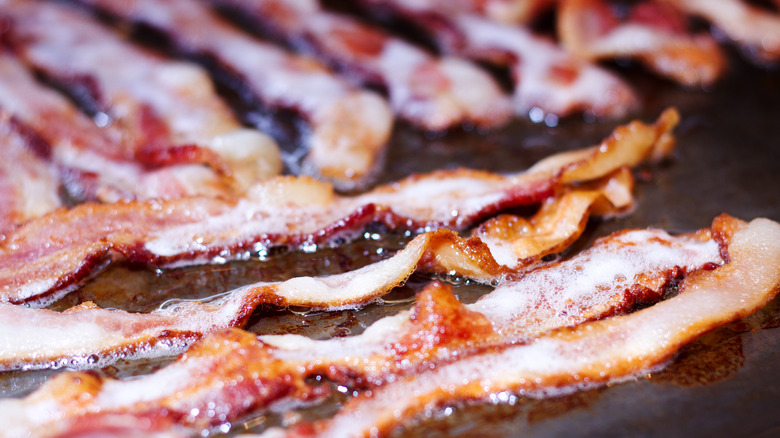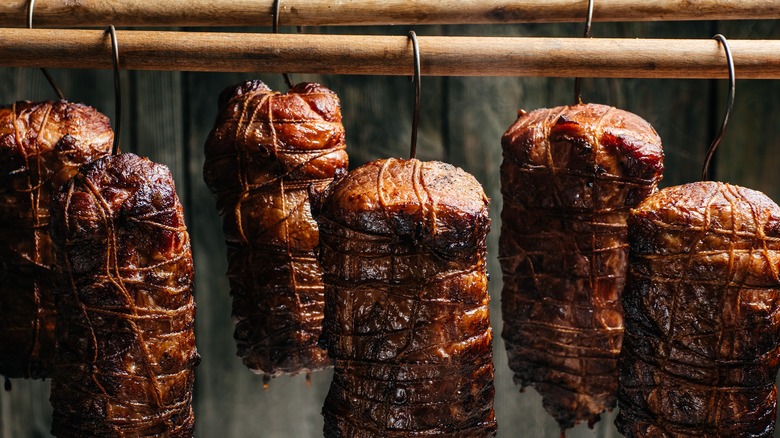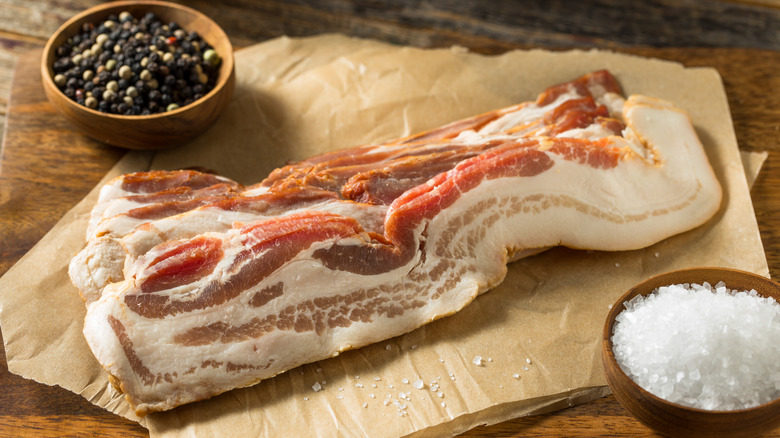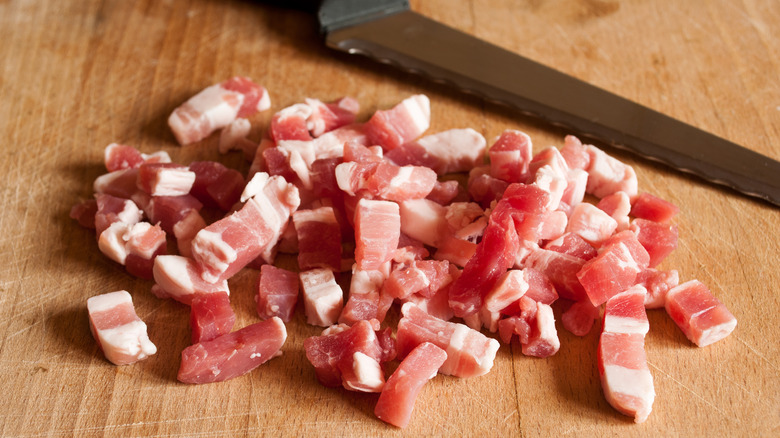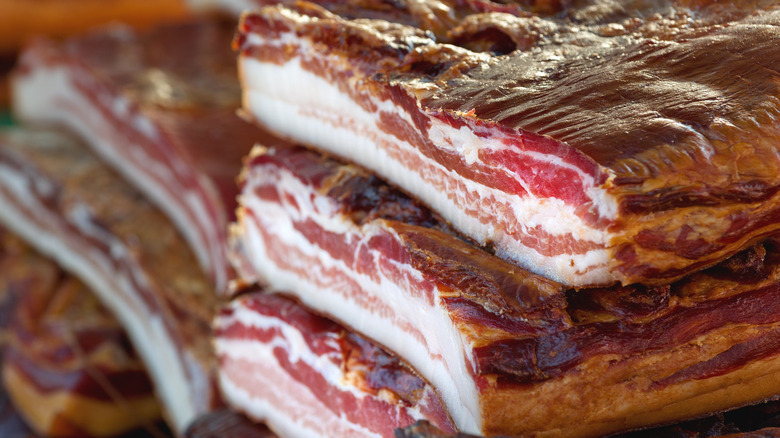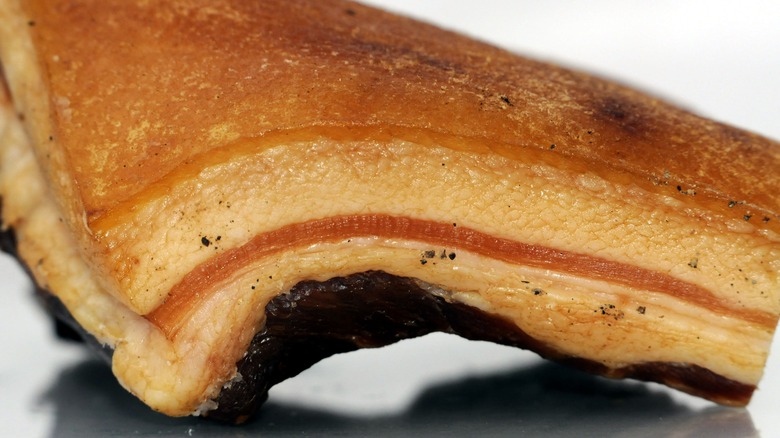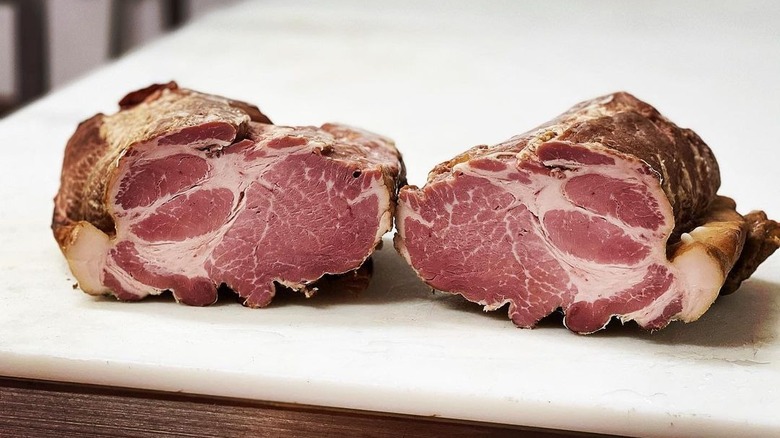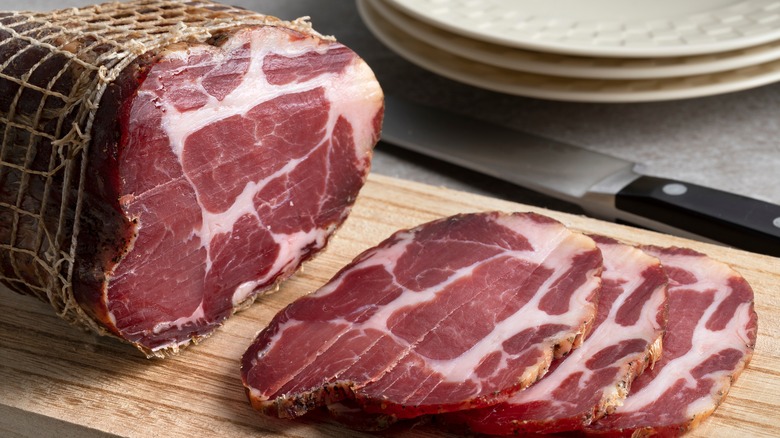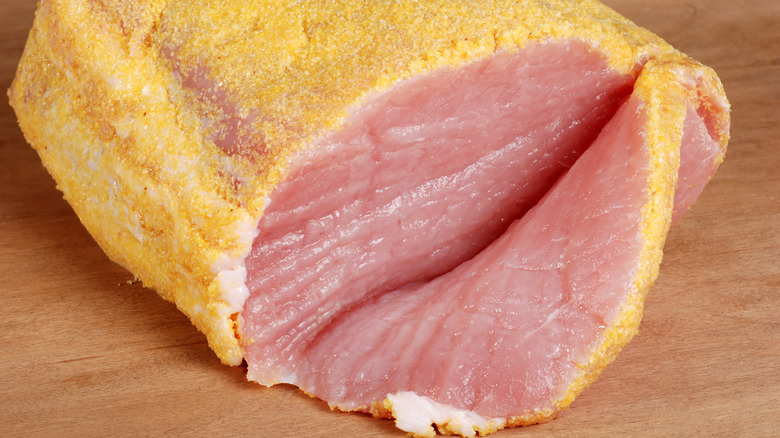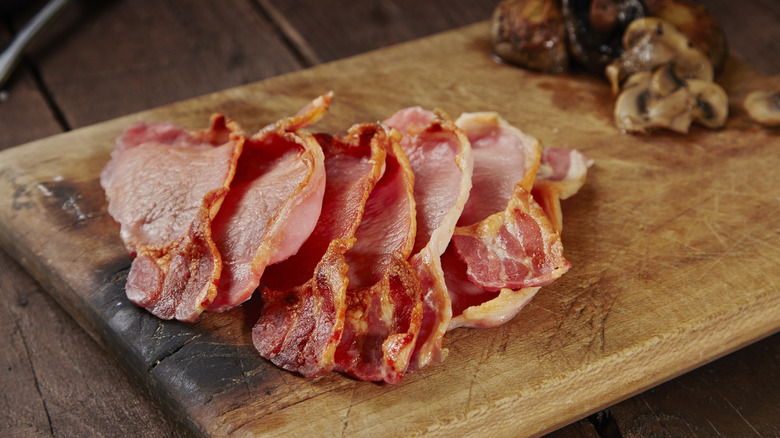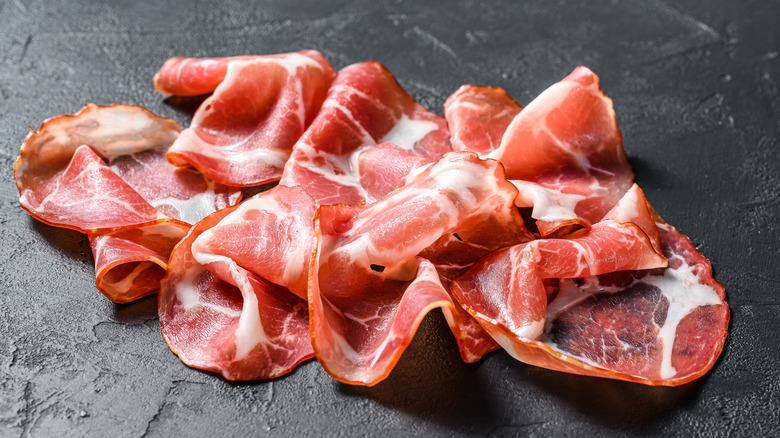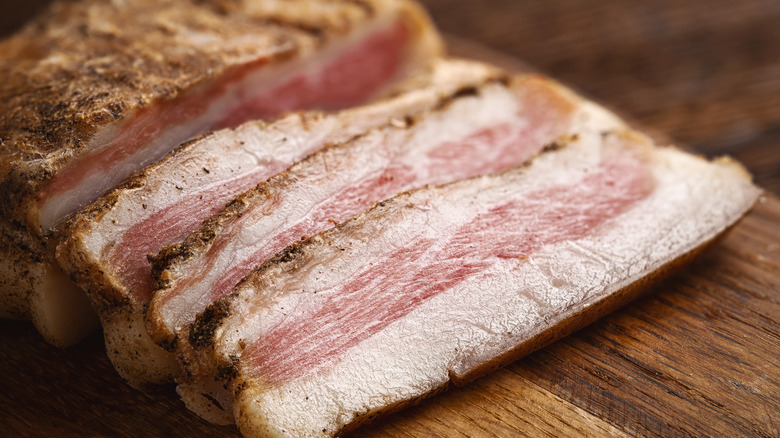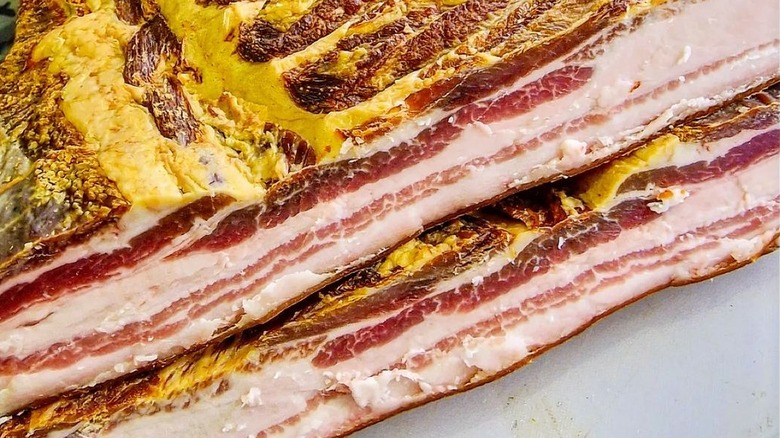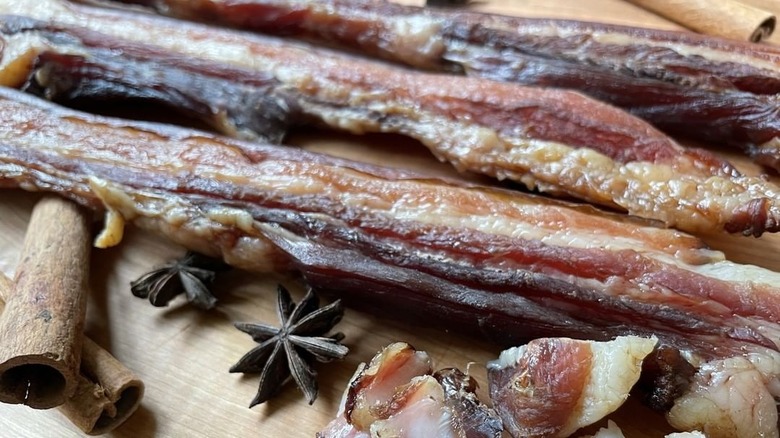The Ultimate Guide To Bacon Varieties
For many people, just saying the word "bacon" conjures memories and visions of delectable breakfasts, pitch perfect BLTs and club sandwiches, and whatever bacon-wrapped concoction tops their list of appetizers or party food. Whether you prefer it crispy or with a bit of chew, the fatty, salty pork known as bacon comes in many different forms and, perhaps surprisingly, by many different names.
Depending on where you live in the world, the definition of bacon might not even be exactly the same. According to the United States Department of Agriculture, bacon is specifically cured pork belly, though cured meat from other parts of the pig can be called bacon as long as the location is specified — like with "pork shoulder bacon," for example. The American Meat Institute, on the other hand, stipulates that bacon can only be cured or processed pork.
It's no surprise given the somewhat broad definition of bacon that the varieties of (and names for) bacon around the world can be overwhelming. If trying to choose bacon at your local market is making your head spin, you've come to the right place. This is the ultimate guide to bacon varieties.
Streaky bacon
While you may not have heard the name streaky bacon, if you're American it's almost certainly what you've been eating as breakfast bacon your whole life. In fact, it may be the only type of bacon you've ever had. Also called "American bacon" for its ubiquity in the United States and "side bacon" for the location on the hog from which it is cut, streaky bacon comes from a pig's side/belly, has a high fat content, and is most commonly found in long strips that are reminiscent of grade school rulers. The fat that runs through the strips of streaky bacon is what gives it its streaky appearance and name.
Because of all that fat, streaky bacon produces quite a bit of bacon grease when it's cooked and should be cooked slow and steady for even, delicious flavor (and an experience less likely to result in a painful grease burn).
Smoked bacon
If you read "smoked bacon" on the package at the market and aren't sure exactly what that means or why there are so many different types of smoked bacon, rest assured it's really pretty straightforward. Most of the bacon you'll readily find at a large grocery store is smoked, which essentially means that after it's cured (more on that soon) it is smoked and heated to around 130 degrees Fahrenheit. The tricky thing to look for on the package is whether the bacon is actually smoked or if the bacon producers decided to cut corners by infusing their bacon with liquid smoke. The clue is right there on the package, where something like "hardwood smoked" or "naturally smoked" means it was actually put into a smoker.
So what's the difference between all the smoked bacon varieties? The type of wood used to create the smoke for smoking bacon imparts distinctive flavors in the finished product and virtually every type of smoked bacon you see in the store refers to that wood (maplewood, applewood, cherrywood, mesquite, etc.).
Uncured bacon
You may recall (from the definitions of bacon we provided) that bacon is a type of cured pork — so you may really be scratching your head about uncured bacon. Curing is the process that makes bacon different from raw pork belly and it's what gives bacon its distinctive color (and a bit of its distinctive taste) as well as what helps preserve it for a bit longer than other raw pork. The reality is that what you see labeled as "uncured bacon" is bacon that doesn't contain artificial nitrates in its curing solution. The nitrates are still there, but they just come from natural sources like celery or sea salt that's high in nitrates. Truly uncured bacon is a myth – after all, it's right there in the definition of bacon.
So why the confusing name? It all comes down to marketing. Several scientific studies have linked nitrates and nitrites to cancer, and the American Cancer Society recommends a diet low in processed meats like bacon (or eliminating them altogether — gasp!), so by labeling bacon as uncured, it's more likely to be seen as healthier or safer than other bacon. Sneaky marketing!
Lardons
Watch a few cooking shows long enough and you'll eventually hear someone talk about pork lardons. They sound so fancy with their French pronunciation (lar-DOANS) and a package typically costs more than a similar sized package of standard bacon. So what are they? The beauty of lardons is that their small size makes them perfectly crispy, while still being meaty. They hold their shape without getting too greasy. But here's the dirty little secret about these small strips or cubes of salty, fatty, pork goodness: They're simply cut up bacon. Seriously!
If you have some bacon in your refrigerator and cut it into matchsticks or cubes, you've got yourself some lardons. Fry them up and sprinkle them on your salad or add them to your pasta. Heck, just munch on them as a snack. You're clearly a fancy chef if you have lar-DOANS on hand and you can eat them however you want. Sure, if you want to get technical then lardons are typically cut off of slab bacon (more on that to come), but they're still perfectly delicious when they come from your already-purchased streaky bacon, too, especially if it's thick cut. Trust us.
Slab bacon
It's possible you've never seen slab bacon in your typical grocery store, but visit your local butcher and you'll be able to pick some up. Slab bacon is essentially what you have before your typical streaky bacon is cut into strips. It's the cured and smoked side of pork (pork belly) in its otherwise natural state. Cut off a little or a lot, thick or thin, depending on what you desire.
If you're going to be using a lot of bacon in a lot of different forms, slab bacon might be just the right pick for you. Cut off thick slices then cut those slices into matchsticks for the aforementioned lardons or cut off big chunks to season your beans or soups. Or just slice it up into streaky bacon and proceed as usual. Slab bacon is for the serious bacon lover who wants to customize their bacon down to the very last slice and we can't say we blame you.
Jowl bacon
If you're familiar with cooking in the American South, you've probably heard of jowl bacon (also called hog jowl), but otherwise this may be a completely new term for you. Jowl bacon is cured meat that comes from a hog's cheek and it comes with the rind (the skin) still attached. It's especially common as a seasoning agent in Southern classics like collard greens and black eyed peas, but can be used to season a variety of soups, beans, peas, and greens, really anything you're cooking over low heat for a long time. This is another cut that you might have to go to your local butcher to find and while the name can be off-putting, the flavor and texture advantages are unmistakable.
While it is most well known in the United States as a seasoning agent, it can be cut up and fried just like other bacon. Because the muscle in a pig's cheek isn't used as much as the muscles in other parts of its body, jowl bacon has a silky texture when cooked properly and is naturally sweeter than other meat that comes from a pig.
Cottage bacon
If you're looking for bacon with a little more meat and a little less fat, cottage bacon (also known as buckboard bacon) is a great cut. Unlike streaky bacon, which comes from the belly/side of the pig, cottage bacon comes from a pig's shoulder. Because of the shape of the shoulder, cottage bacon comes in wider pieces than the traditional long strips of streaky bacon. The size of cottage bacon makes it perfect for a sandwich and much easier to cook on a grill. Plus, since cottage bacon is leaner, you don't have to worry about a ton of grease dripping down into the bottom of the grill and causing it to flame up. What better cut of bacon to add to your next cookout to top your burgers?
If you're feeling especially adventurous, you can even make your own cottage or buckboard bacon by curing a pork shoulder or pork butt (also confusingly part of the shoulder), there are even special curing blends you can buy for exactly that purpose! Now that's taking your bacon to a new level.
Collar bacon
Another type of bacon from pork shoulder, collar bacon comes from the part of a pig's shoulder closest to the bone. As Snake River Farms explains in this video all about pork shoulder, the pork collar is a smaller cut that actually composes part of what we call the pork butt or Boston butt — it's just arguably the most delicious part. The meat is darker, there's great fat marbling throughout the meat, making it super tender and deliciously crisp when it's rendered.
While you're probably much more familiar with this type of pork cut being used for things like pulled pork or a pork roast, using the collar to make bacon is an exciting twist on all your bacon needs. Though you may not find it in your local grocery store, a quick visit to the butcher is all you need to get your hands on some collar bacon. And it's never a bad idea to form a neighborly relationship with your local butcher for all your meat needs.
Peameal bacon
When you hear the term Canadian bacon, you probably think of the pre-cooked meat that's more akin to ham and is most commonly found on pizza or Egg McMuffins. If you want true Canadian bacon, however, you're going to want peameal bacon. Both peameal bacon and what Americans think of as Canadian bacon are a form of back bacon, somewhat akin to British rashers. Where peameal bacon and Canadian bacon differ is that what we call Canadian bacon is both cured and smoked or brined, making it completely edible right out of the package, while peameal bacon isn't typically smoked and is often pickle cured and coated in cornmeal or, as the name suggests, peameal.
According to Atlas Obscura, peameal bacon also has all the fat trimmed off. That, plus its cooking requirement that leads to a crispy edge thanks to the cormmeal or peameal, makes it a very different texture and flavor than what you might expect on your breakfast sandwich if you order Canadian bacon — though still completely delicious. After all, the peameal bacon sandwich was declared Toronto's signature dish in 2016.
Rashers
If you're from the United Kingdom, it's likely you refer to rashers of bacon rather than strips, but what many Americans may not immediately realize is that British or Irish bacon is different from American streaky bacon in more ways than just the name. British or Irish rashers of bacon are also called back bacon and are a combination of pork loin and side/belly bacon, in one cut. Though somewhat similar to cottage or buckboard bacon at first glance, rashers of back bacon have less fat than pork belly bacon so they cook a bit faster; while the pork belly portion enables a bit more of a crisp, the loin portion offer a salty, meaty piece that the British find perfect for a full English breakfast.
If a full English breakfast isn't your thing, try a bit of back bacon for your next BLT or to top your burger. You'll get that great bacon flavor you're used to with a meatier bite. You might never want to go back to streaky bacon though, so don't say we didn't warn you.
Pancetta
You've probably seen packaged pancetta in your local grocery store both cubed and sliced thin, but may have wondered what it is (and may have even confused it with prosciutto a time or two). Pancetta is Italian cured pork belly and is not smoked, unlike American streaky bacon. Also unlike American streaky bacon, pancetta can be eaten in its "raw" form, according to Volpi foods, due to the curing process, which for American streaky bacon takes just a little over a week, but for pancetta is done for two to three weeks.
The beauty of pancetta is that it can also be cooked for a crispy, flavorful addition to dishes with a bit more dimension than streaky bacon thanks to the curing and aging. You'll commonly find pancetta in Italian pasta dishes like pasta carbonara and creamy pasta with pancetta and peas, but it can also be a great addition to charcuterie boards.
Guanciale
Guanciale is another one of those pork products that you may have only heard of on your favorite Food Network cooking shows. It's spoken of in hushed and sexy tones like some amazing Italian secret you're only reluctantly being let in on. Just like pork lardons have their dirty little secret of just being cut up pieces of typical bacon, guanciale has a little secret, too. It comes by another, less appetizing name in the United States — jowl bacon. That's right! The highly sought after guanciale your favorite television chef uses comes from the Italian word for cheek. Don't get suckered into paying for high-priced guanciale from a specialty Italian importer when your local butcher can get you the exact same cut of meat.
Sure, guanciale is often heavily seasoned with things like pepper, rosemary, garlic, and sage — whereas hog jowl in the American South is more straightforward. But the texture and flavor of the pork itself are going to be the same. Guanciale is great for a special occasion or if you want a truly authentic dish like pasta alla gricia, but don't be fooled by a fancy name if what you're looking for can be accomplished with guanciale's more humble cousin.
Szalonna
If you're learning anything about bacon from this deep dive, it's hopefully that bacon around the world comes with all sorts of unique flavors and curing techniques. The bacon from Hungary, called Szalonna (or historically sometimes Gypsy bacon), is no exception. On the completely opposite end of the spectrum from super lean peameal bacon, szalonna comes from the fattiest cuts of pork and is preserved either by salt curing or smoking it. Like many other Hungarian dishes, there's also a healthy dose of paprika and garlic.
According to Taste of Hungary, szalonna is most often used in dishes like soups or stews, but there are seemingly countless different kinds depending on the spices used and the smoking or curing method. It can be sliced thin and eaten without cooking (as it's safe to eat thanks to the curing and smoking), or even cooked up like your other favorite fatty bacon cuts. For the true Hungarian experience, try roasting your szalonna over an open fire at a szalonnasütés, also called a bacon roasting or a bacon fry.
Lap yuk
According to historians, bacon got its start in ancient China so we can't talk about bacon varieties without talking about Cantonese lap yuk. Like American streaky bacon, lap yuk is made using pork belly, but that's really where the similarities end. Lap yuk is made by soaking raw pork belly in rice wine, soy sauce, salt, ginger, scallions, and other spices before traditionally being hung up to cure in the cold open air in fall or winter, not in a smokehouse or meat house like other types of bacon.
While you can certainly make it yourself using a number of recipes floating around online, according to a relative of a writer for The Guardian you just can't replicate the flavor of lap yuk from Southern China because of the native spores and bacteria in the air.
If a trip to Southern China isn't within your budget and you're not quite ready to try making your own, visit your nearest Chinatown market for lap yuk that's as close to authentic as you can find outside of China. Eat it with a bit of white rice or mix it into other dishes like fried rice, stir fry, soups, risottos, or wherever else your imagination leads you.
